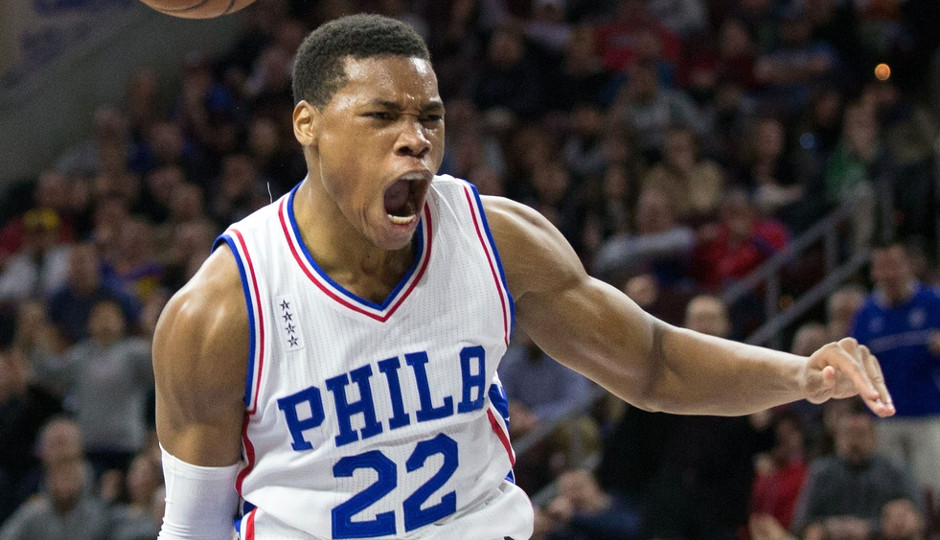Likes and Dislikes: Richaun Holmes Emerging for Sixers

Richaun Holmes celebrates a dunk during the Sixers’ 109-99 victory over the Minnesota Timberwolves | Bill Streicher-USA TODAY Sports
Each week we’ll dive into a couple of observations about the Philadelphia 76ers. You can view previous installments in the Likes and Dislikes series here.
This week we’ll talk about the emergence of rookie big man Richaun Holmes, the Sixers’ newfound ability to close out games, and the recent struggles of Robert Covington.
Like: Richaun Holmes Continues To Impress
When 76ers rookie big man Richaun Holmes has gotten a chance to play, he’s been impressive.
Holmes has received at least 15 minutes of play in 13 games this season, where he’s posted averages of 10.2 points, 3.1 rebounds, and 1.1 blocks per game in 20 minutes per night while shooting 60.7% from the field in the process.
Filtering out statistics like that for players who don’t receive regular playing time is, admittedly, not the greatest measure, as coaches tend to leave bench players in games longer when they’re playing well.
Still, Holmes has more often than not made a positive impact on the game for the 76ers, which most recently included a 17 point explosion against the Minnesota Timberwolves on Monday night.
For rookies who have played at least 200 minutes so far this season, Richaun Holmes ranks 5th in win shares (1.2), 4th in box score plus/minus (also at 1.2), and 1st in true shooting percentage (64.0%), a product of nearly 60% of Holmes’ field goal attempts coming from within 3′ of the basket, where he’s shooting 81.2% on the season.
| Player | % of FGA Within 3' | FG% Within 3' |
|---|---|---|
| Richaun Holmes | 59.5% | 81.2% |
| Nerlens Noel | 51.1% | 70% |
| Jahlil Okafor | 43.2% | 63.6% |
Holmes has shown flashes of a perimeter jump shot, but it’s been his work near the rim that has made him effective. He has good hands, can catch the ball in traffic, elevates quickly around the rim, has the strength to play through contact, and has good touch around the hoop with either hand. This makes him a threat off of pick and rolls, offensive rebounds, and cuts to the hoop, all of which he’s utilized in the last two games.
Holmes has some weaknesses he still has to fix, chief among them defensive rebounding, where he’s pulling down just 7.8% of the available defensive rebounding opportunities while he’s been on the court. That’s really bad. It’s actually the lowest rate among the 82 players 6’10” or taller who have played at least 300 minutes so far this season. In fact, he’s the only such player in single digits.
Defensive rebounding is one of the ultimate team activities, and sometimes players can box their man out and allow others to collect the defensive rebound, but that doesn’t seem to be the case here. The Sixers rebound worse on the defensive side of the court with Holmes in the game, going from collecting 78.7% of the available defensive rebounds when he’s on the bench to only 74.2% when he’s on the court, and he only hauls in just 1 contested defensive rebound every 5 games, per nba.com/stats.
Part of the problem is likely related to his shot blocking instincts, but there are certainly instances where he could do a better job of getting in position and anticipating the defensive rebound. But even with that area he needs to improve upon, his athleticism, ability as a roll man (which could become even more of a positive with Ish Smith in the fold), and shot blocking suggest the Sixers found a potential keeper in the second round.
Like: Closing Out Games
Over the first 31 games of the season the Sixers were really bad at closing out games. Like, comically bad. Up to that point the Sixers had played in 11 games where the game was within 5 points with 5 minutes or less remaining, and they lost all 11 of them, being outscored by 72 points in those “clutch” situations, with an offense that averaged just 55.8 points per 100 possessions and turned the ball over on more than 25% of their possessions.
(Note: the second worst non-Sixers “clutch” performances this season are 94.4 points per 100 possessions and with turnovers on 16.6% of their possessions, respectively).
Since the acquisition of Smith, however, that has been a different story. They’ve only been in 10 minuets worth of “clutch” situations (5 minutes or less remaining, game within 5 points), but they’ve looked far more like a functional NBA offense, scoring 109.7 points per 100 possessions and only turning the ball over 14.3% of the time.
There’s obviously some noise to those statistics, as the +18.0 Net Rating (points per 100 possessions differential) would place them favorably against the clutch statistics of any non-Warriors team in the NBA, and they’re clearly not talented enough to maintain that. Having played against the Suns, Kings, Wolves, and injury-depleted Jazz certainly helps inflate the results. But it’s clear they’ve executed better down the stretch, and it’s fair to wonder how many more of those close games earlier in the year they may have won if Smith was here for the entire season.
Dislike: Robert Covington’s Struggles
Robert Covington was one of the legitimate bright spots for the Sixers’ 2014-15 campaign, averaging 13.5 points and 4.5 rebounds, while shooting 37.4% from three point range on high-volume, high-difficulty attempts, after the Sixers signed him out of the D-League last November.
Covington looked ready to build on that success in the preseason, where he averaged 13.2 points and 5.5 rebounds per game, while shooting 42.9% from three point range, before spraining his right MCL in the preseason finale against Boston.
This caused a somewhat-expected slow start to the season for Covington, who missed the first two games of the season, tried to play (ineffectively) in the third game of the year against Cleveland, then missed the next 7 games because of the same injury. Even when Covington returned, he wasn’t the same, as he missed his first 18 three point attempts of the season.
But then Covington seemingly got his legs under him and returned to the player he was last year. Between November 21st and December 16th, a span of 14 games, Covington averaged 15.6 points per game and shot 37.8% from three point range despite attempting nearly 8 three pointer shots per game.
Not only did Covington return to being the same reliable, high-volume three point shooter he was last year, but his all-around contributions rose: he averaged 6.8 rebounds and 2.5 steals per game over that span as well.
Since that time Covington’s game has fallen off a cliff, as he’s averaging just 5.4 points on 29.5% shooting over his past 10 games, including just 25.8% from three pointers when his defender is 4+ feet away from him at the time of the shot. This is easily the toughest stretch of his professional career.
| Time Period | Points/Game | 3PT% | "Open" 3PT% |
|---|---|---|---|
| 2014-15 | 13.5 | 37.4% | 39.3% |
| Nov 21st 2015 to Dec. 16th | 15.6 | 37.8% | 40.3% |
| Since Dec 16th, 2015 | 5.8 | 25% | 25.8% |
Before Monday night’s 109-99 victory over the Minnesota Timberwolves, head coach Brett Brown said there was nothing physically wrong with Covington to cause his struggles.
“Nope [he’s not hurt],” Brown said. “He’s not even close to where he was. I don’t know [why he’s struggling].”
The struggles, Brown says, have impacted Covington’s spirit, and his defensive energy.
“I think he’s down defensively at times as well. I think that his spirit is a little bit bumped around,” Brown said. “I really do look at it from my perspective as I have to help him, I have to find a way to get him back.
“I think over 82 games it’s naive of us to think that people don’t fall into slumps,” Brown continued.
Especially with some of the Sixers’ other three point shooters struggling with bouts of inconsistency as well, and for the Sixers’ ability to evaluate Jahlil Okafor’s offensive impact with the addition of Ish Smith, getting Covington back to being the regular contributor he was last season is a high priority.
Derek Bodner covers the 76ers for Philadelphia magazine’s Sixers Post. Follow @DerekBodnerNBA on Twitter.


